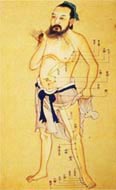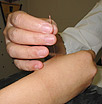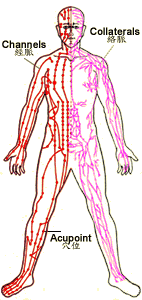What is Meridian System ?
The Concept of Meridian
"Jing luo", the Chinese term for meridian has two interesting concepts which make up the basic structural components of the meridian system. These concepts date back thousands of years and are reflected in the ancient Chinese medical text, Yellow Emperor’s Classic of Internal Medicine, which says: “Jing are in the interior, their branches that run transversely are luo, and the further branches are sun.” Literally, jing means to pass through or pathway and refers to the vertical channels, luo means something connected or attached and refers to intricate network of interconnecting branches; jing luo mean channel network for connecting and communicating. Basically, the channel meridians (jing mai) run vertically deep inside the body, the collateral meridians (luo mai) run transversely and locate in relative superficial part and some even on the body surface. The meridian system is constructed from channels and collaterals that run in regular paths but interconnect closely. It links up all the major organs, limbs and trunk, sense organs, bones and tendons, and even muscles and skin that make the human body an organic whole and so ensure its life activities. Meridians are not blood vessels
Meridians are not blood vessels Although meridians work as a channel system which carries and distributes qi (vital energy) and blood around the body, they are not blood vessels and have no anatomical structure identified. Many meridian research projects have been carried out over the years testing different hypotheses of how this system works. Physiological hypotheses such as nervous reflex models have been put forward, but researchers have not yet come up with a definitive model that can give a complete anatomical description of the meridian system.
Origins of the Meridian System
According to the ancient medical literatures, it is hypothesized the meridian theory developed in the following ways: 1. Observation of a "needle" feeling projected elsewhere in the body

When certain specific points on the skin were pierced by fine needles, feelings like soreness, numbness, heaviness and swelling would occur, a reaction known as the "needle" sensation. It was found these "needle' feelings were always felt on a particular skin area, following a certain direction and pathway. Ancient Chinese healers worked out the patterns of the needle points (acupuncture points) in the body, which later formed the basis of the meridian theory.
2. Observation of the effects of acupuncture points
In ancient times, Chinese people would experiment and stimulate different acupuncture points to get symptomatic relief from a particular ailment. As they practiced these acupuncture trials, they found points with similar effects were always distributed in an organized pattern. After generalized and classification, a meridian map of the body was created.
3.Correlation of certain illnesses with acupuncture points
From every day experiences, Chinese people gradually recognized when a particular disease or organ disorder occurred, they would feel pain in a particular part of their skin, which was often associated with a rash or skin color changes. These correlations were analyzed according to the ancient philosophies such as the yin-yang and the five elements theories and further developed into an integrated scientific and artistic model for maintaining health in TCM. It is generally agreed that the meridian theory was primarily created from experiential, that ancient Chinese summarized experiences received in deep meditations and through empirical explorations during healing.
Structural Components of the Meridian System
The meridian system is basically constructed by channels, collaterals and associated parts. There are twelve regular meridians (channels) that form the backbone, they run vertically inside the body, the hand or foot are either their end points or start points. Along the paths, each of them branch off a divergent channel, a connecting collateral, and many minute and floating collaterals. Since the branches of one regular meridian connect specifically to a zang organ, a fu organs, a bundle of tendons and a skin segment, the connections make up a special functional unit.

Twelve regular meridians
They are the main pathways for qi and blood circulation, including three yin and three yang meridians in each arm, and three yin and three yang meridians in each leg:
- Arm Tai Yin Lung Meridian
- Arm Yang Ming Large Intestine Meridian
- Leg Yang Ming Stomach Meridian
- Leg Tai Yin Spleen Meridian
- Arm Shao Yin Heart Meridian
- Arm Tai Yang Small Intestine Meridian
- Leg Tai Yang Bladder Meridian
- Leg Shao Yin Kidney Meridian
- Arm Jue Yin Pericardium Meridian
- Arm Shao Yang Triple Burner Meridian
- Leg Shao Yang Gall Bladder Meridian
- Leg Jue Yin Liver Meridian
Twelve divergent meridians
Each of the twelve regular meridians has a major branch that diverges in the limbs, travels within the body, and connects the internal organs. They also link to certain organs and body parts that the primary meridians do not reach.
Twelve sinew meridians in tendons
These are the parts of the twelve regular meridians that connect with the tendons, ligaments and connective tissues, mainly responsible for joint and body movement.
Twelve cutaneous regions
These are the parts of the twelve regular meridians that connect with the skin, forming reaction areas on the body surface.
Eight extra meridians
The eight extra meridians are the Governor Vessel, Conception Vessel, Thoroughfare Vessel, Girdling Vessel, Yin Link Vessel, Yang Link Vessel, Yin Heel Vessel and Yang Heel Vessel. They do not link to the internal organs directly, their main functions are to strengthen the links between the twelve regular meridians and also act as reservoirs of the fundamental substances, buffering the blood and qi circulation. The Governing Vessel and the Conception Vessel are considered the most important channels among others, because they have their own specific acupuncture points, and are not attached to the twelve regular meridians.
Fifteen connecting collaterals
These include the twelve collaterals that branch off in the limbs from the twelve regular meridians, two branches from the Governor Vessel and Conception Vessel in the trunk, as well as one great collateral from the spleen meridian. Their main roles are to enhance and regulate the communications between the yin and yang paired meridians. Meridians linked with yin organs are known as yin meridians; if they are linked to yang organs, they are known as yang meridians.
The meridian system relies on the collaterals to branch out a network and spread throughout the body, in which minute collaterals (sun luo) are regarded as the finest branches, and the floating collaterals (fu luo) are regarded as the most superficial branches.
Acupuncture points along the meridians
The flow of qi in the meridian system concentrates or gathers in certain areas of body surface, where makes the qi more accessible along the meridians. These areas are very small points, otherwise known as “acupuncture points” or “acupoints”. Although acupuncture points are located externally and superficially, they can affect the internal functions of our body. For example, puncturing on them can dislodge blocks in the meridians which help qi flowing and regulate organ functioning. Each point has specific function that corresponds to its serviced organ system. The most powerful points tend to locate at the ends of the meridians such as in the extremities.
There are over 365 acupuncture points (twice if counting on both sides), and most of them are along the major 20 channels (twelve regular meridians plus eight extra meridians). There are also plenty of a-shi point and extra points that do not belong to any of the meridians but have special therapeutic effects for some diseases.


